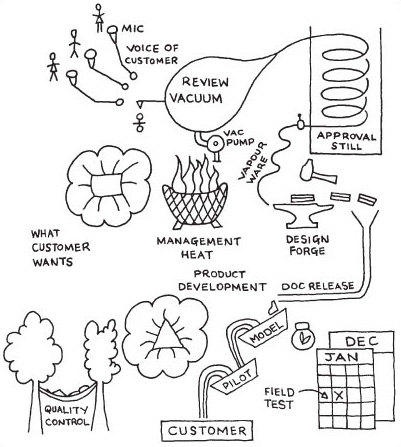Stage 2: The situation analysed
The first step is to develop a picture (called in soft systems terminology a rich picture) that encapsulates all the elements that people think are involved in the problem. Once the rich picture has been drawn, the analyst will attempt to extract ‘issues’ and key tasks.
Issues are areas of contention within the problem situation. Key tasks are the essential jobs that must be undertaken within the problem situation.
SAQ 13
The essence of rich pictures is that they represent all the elements in a situation in an unstructured way. By all the elements I mean both ‘hard facts’ (if there are any) and the softer, more subjective aspects of the situation being considered. Look at the rich picture of a new product introduction process shown in Figure 37, then answer the questions.

-
(a) What situation do you think may have led to the drawing of the rich picture?
-
(b) What are the hard elements in the situation?
-
(c) What are the soft elements in the situation?
-
(d) Briefly write the ‘story’ that the rich picture tells.
Answer
-
(a) The situation that led to the rich picture being drawn might have been a dissatisfaction with the new product introduction process in terms of its ability to deliver what the customer wants or the time that it takes.
-
(b) The hard elements in the situation could be:
customer wants
product as delivered
dates of tests
though all these have ‘softer’ elements.
-
(c) The soft elements are:
management heat under the review vacuum
quality control sleeping peacefully
the gap between the voice of the customer and customer wants
the convoluted ‘pipe’ of management approval.
-
(d) The story that the picture tells is one in which the voice of the customer is elicited and defined, albeit with imperfect transmission of requirements. The requirements are then reviewed with management urging action leading, perhaps, to premature decisions about requirements. Approval takes a long time and results in ‘vapourware’ that influences the design process. Documents are released from design into product development, which produces models and undertakes field tests and pilots. The product is then delivered to the customer but is not the same as what was wanted. And all the while, quality control slumbers on.
